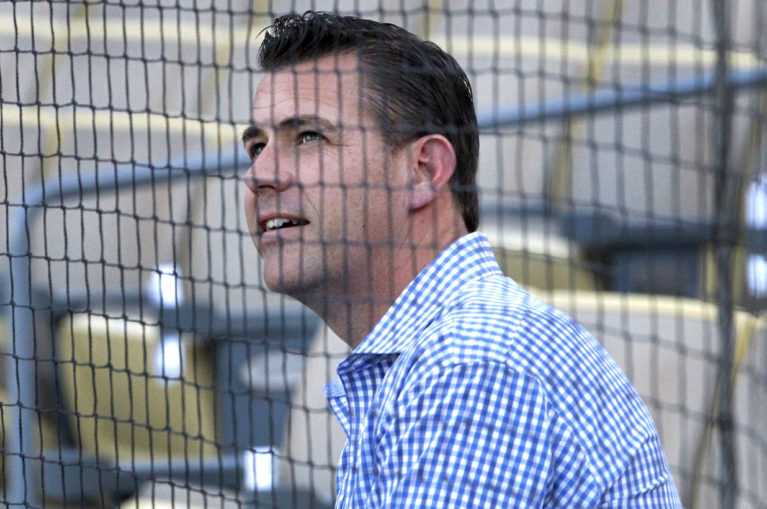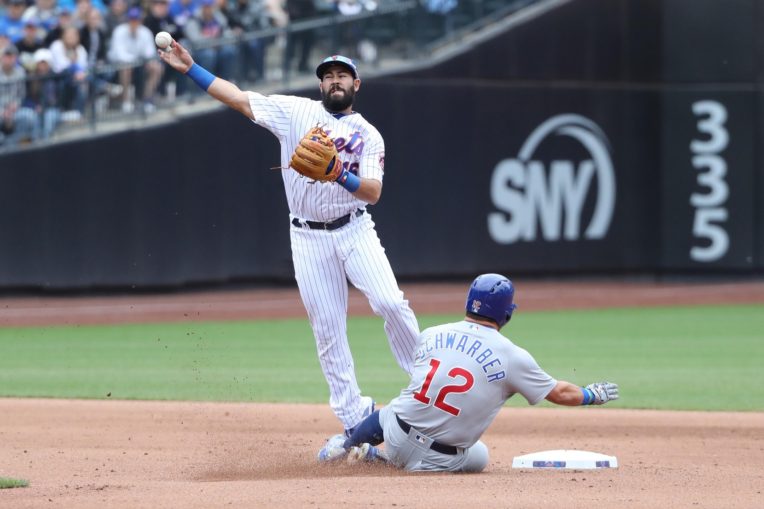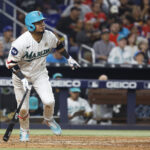
Charles Wenzelberg/NY Post
Say it with me now: “Depth wins championships”. If this saying is truly the case, then maybe take the over on the Mets at 83.5 wins, who arguably have the best infield bench of any team in the majors after a hectic offseason.
Following a blockbuster deal for Robinson Cano and Edwin Diaz, the Mets swung another trade for J.D. Davis and inked a contract with Jed Lowrie, leaving any of Cano, Lowrie, and Davis to fight for infield time with Jeff McNeil, Todd Frazier, Amed Rosario, Peter Alonso, and Dominic Smith. I know, the Lowrie signing and the Davis trade make no sense – why make the infield so crowded? Fear not – the crowded infield is completely by design.
At a press conference in December, Mets GM Brodie Van Wagenen spoke at length about his plans for the offseason, “One of the things that I think this club suffered from the last couple years was putting a lot of weight into ‘ifs’. If player X is healthy, if player X rebounds to have another year, if we have a breakout season from a young player. My goal is that we try to eliminate as many ‘ifs’ as possible. To be able to have premier talent and to be able to have versatility on the roster that gives us depth so that we’re not vulnerable by any one particular breakdown.”
This quote received a good deal of attention at the time, and it deserves your attention again as the Mets move forward with a strategy that has served other teams well—focusing on depth.

For examples of the virtues of depth, look at the 2018 NLCS teams—the Los Angeles Dodgers and Milwaukee Brewers. Both teams had loaded up on talent during the offseason that seemed redundant, picking up depth at positions where teams were already deep. These moves took away playing time from some very good players and crowded the roster—both teams had loaded up on outfield and first base depth. For the Brewers, Eric Thames and Domingo Santana—breakout stars from 2017—were left positionless, and the Dodgers were left juggling Joc Pederson, Enrique Hernandez, Yasiel Puig, Chris Taylor, Cody Bellinger, and Matt Kemp in the outfield.
But it worked nevertheless. The Dodgers, beset upon by some of the worst injury luck in the league according to my mid-season study on injury production lost for The Athletic, had enough depth that they might still have made the playoffs without mid-season acquisition Manny Machado. Meanwhile, the Brewers doubled down on acquiring as much talent as possible midseason en route to a deep postseason run.
These teams loaded up their rosters with good players without overly concerning themselves on strict positional depth. Rotating and aggressively platooning players led to more favorable matchups and more consistent rest for starters, and by having a high-quality bench (the Dodgers would sit two, and sometimes three, outfielders every night who were talented enough that they might have warranted starting 150+ games if they played for other teams) the drop-off in production in the lineup caused by starting “reserve” players was far less a penalty than that incurred by other teams. When you give McNeil a day of rest and start Jose Reyes instead, the relative drop-off in production is far worse than the drop-off in production from giving Pederson a day of rest and starting Kemp instead.

Contrast this with the Mets’ top-heavy roster construction: entering 2018, the team lacked serious outfield depth, had Luis Guillorme and Reyes serving as backup infielders, and the starting rotation was dramatically depleted before the team even took the field on opening day. Predictably—given the Mets’ consistent injury woes—the top-heavy team fell apart as soon as key contributors were injured as the Mets squandered their early-season momentum. Yoenis Cespedes, Travis d’Arnaud, and Jay Bruce all were felled for significant portions of the year if not all of it, and Reyes, Austin Jackson, and Devin Mesoraco saw significant playing time in the second half—to the detriment of the team.
There is arguably a more efficient way to insure the team against injury issues—that is, establishing a better protocol for handling injuries and training within the organization that is insulated from interference by ownership, whose meddling has been apparent and disastrous according to numerous external reports, such as this from Jerry Crasnick two years ago. But creating a team with a quality bench accomplishes this same goal while protecting Jeff’s ego, and simultaneously employs the same building philosophy as successful teams such as the Dodgers, Brewers, and Cubs. Should a three or four win player for the Mets go down, they can be replaced by a two or three win player with ease—and with additional rest, the odds of going down to injury should decrease.
I must confess that I thought the Mets were building the same top-heavy team when they acquired Cano, and I took Van Wagenen’s comments as mere drivel given to reporters so that they had a quote for a story. But with each successive acquisition, it seemed even stranger—until the Lowrie signing clearly indicated that the Mets were purposefully constructing their roster in such a way so that depth was highly valued. Balancing the roster’s current distribution of talent is tricky, to be sure—but having too many talented players is a problem a manager would love to have.
Van Wagenen has delivered as promised—the Mets truly are insulated against positional breakdown. The Mets are three players deep at nearly every infield position, and Mickey Callaway can feel much better about giving McNeil rest when it’s Lowrie starting in his place as opposed to Reyes. The outfield is much more top-heavy than the infield, but there is a noticeable increase in depth compared to previous seasons, even with Yoenis Cespedes likely sidelined for half the season or longer. A flurry of minor league signings have further complemented the Mets’ depth. There is still some work to do pitching-wise, but make no mistake—Van Wagenen has changed the way that the Mets operate, for the better.















